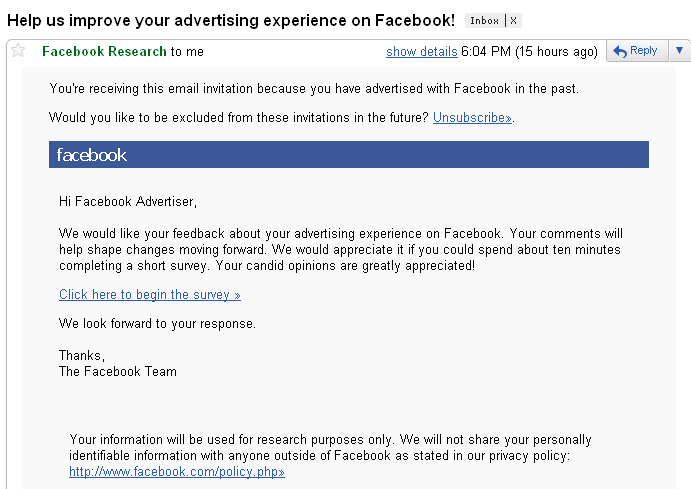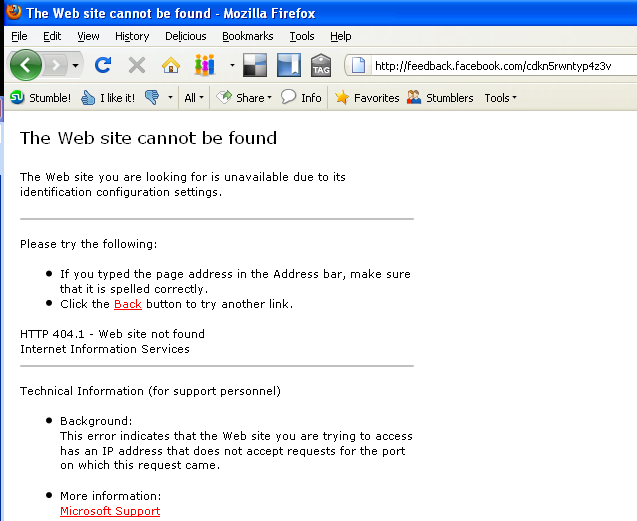 This is the 3rd part of a series analyzing the successes and failures of Facebook in the art of writing and implementing e-mail newsletters.
This is the 3rd part of a series analyzing the successes and failures of Facebook in the art of writing and implementing e-mail newsletters.
In the first part, we analyzed an example of a Facebook e-mail newsletter that was a great example of how to implement permission marketing, how to avoid the brochure mentality, and how to do seamless product placement.
In the second part, we analyzed the mistake that Facebook is doing by by using a no-reply e-mail and hiding away its contact form from its users.
In this third part, we will discuss how Facebook Research did right and wrong when sending a recent survey e-mail on Tuesday, Apr 13, 2010 at 6:04 PM (HST).
About the E-mail

As you can see this e-mail contains 13 lines of text and only 3 links: one for unsubscribing from future e-mails, one for the survey link, and one for the Facebook privacy policies.
The Good
From a text copy point of view, the e-mail is well written: short and straight to the point. Facebook makes it clear why they are sending you the e-mail (“you’ve advertised with Facebook in the past”) and provides a link to its privacy policies.
This e-mail is actionable: take the survey! You can explain the purpose of the e-mail in one sentence: Facebook wants your feedback about your user experience with Facebook Ads. How do you measure the success of the e-mail? Simple: how many people click on the survey link and complete the survey.
If Facebook is smart about its e-mail design, then probably they would have done some A/B testing to test which e-mail design has the better click-through rate and conversion rate (in this case: complete the survey).
The Bad
Facebook Research does not use a no-reply e-mail unlike the Facebook Ads team:

The e-mail address from Facebook Research is: research@feedback.facebook.com
The problem with no-repply e-mails was first pointed out by Seth Godin in his book, Permission Marketing, back in the 1990s, and yet still, 20 years later, there are still a lot of organizations (e.g. Facebook) using this conversation-killer e-mail address.
By having a direct e-mail address, Facebook Research is providing the opportunity for conversations with its users, which is critical for a company in the business of social media.
Until..you try to actually send an e-mail to Facebook Research!
If you write to research@feedback.facebook.com, this is what happens:
Delivery to the following recipient failed permanently:
research@feedback.facebook.com
Technical details of permanent failure:
Google tried to deliver your message, but it was rejected by the recipient domain. We recommend contacting the other email provider for further information about the cause of this error. The error that the other server returned was: 550 550 User does not exists, and you are not relayed (state 14).
Masking a no-reply e-mail to give the appearance of being willing to engage in conversations is a not only a terrible marketing mistake but also a horrible social practice.
The Extremely Ugly
Here’s what happens when you click on the survey link:

Bad Facebook. No cookie for you!
Let’s play devil’s advocate and actually give Facebook the benefit of the doubt, and think about some possible explanations for this:
- Facebook Research received way too many survey responses, so it decided to pull the plug on the survey.
- The server that hosts the survey is under maintenance.
- The person responsible for the e-mail was just having a pretty bad day.
Unfortunately, no matter what excuse Facebook comes up with, it should have either informed the recipients of this e-mail about the error (e.g. server down, wrong link) or about the thank-you-but-we-have-enough responses via an e-mail or image posted after clicking on the link.
Conclusion
Make sure that your e-mails are read by at least 3 people so that they can bullet-proof it by checking broken URLs, mispellings, or any other type of errors.

I received and email to take a survey on how my add its doing in Facebook, Sorry i still don’t understand the terms used and how it works, so far I’ve not been able to advertise because i don’t understand the system. I need to talk to some human that can explain me everything, i really want to advertise. please call me at 787-594-9389, Ramirez